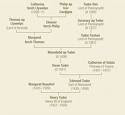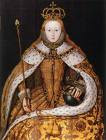There is so much "history" to see in Great Britain, otherwise known today as the more 'PC'-minded "United Kingdon," that it helps to have a way to organize the sites in my opinion. One interesting way to do it is via historical figure. In the case of Tudor England, seeing the sites that have any connection to Henry VIII reduces the potential number of them from thousands to less than a dozen. The following, in my opinion (having recently visited all of them for this very purpose), is a collection of tourist destinations that put a concrete spin on this larger-than-life historical figure.
TRAVEL DESTINATIONS FOR FANS OF HENRY VIII
For a guy that had a big impact on history, Henry VIII didn't actually leave that much of a permanent mark on the world (not that many of us do). Many of the properties that he had built have either been torn down or remodeled past the point of being something that he would have recognized. But to a careful tourist of Britain, there is enough left to get a flavor for the lost world that he was a part of.
Henry himself was born at Greenwich palace, which no longer exists - the spot today is the home of a naval museum. As a child he spent time at Dover and Ludlow Castles, which of course have few traces of the monarch. To get an idea of Henry's world, in addition to the few traces of him in London, there are four main categories of sites to visit: the homes of his wives, Hampton Court Palace, his existing military defenses, and the shipwrecked Mary Rose.
These can be integrated into an approximately five-day trip (calculated conservatively assuming other destinations of interest) that can include some of the places already mentioned.
5-DAY TOUR OF HENRY'S ENGLAND
(2-day stay in London)
Day 1: Tower of London
The tower dates back to William the Conqueror and so Henry isn't responsible for it, but for anyone interested in British history in general, which Henry was a big part of, the Tower should be done at least once. It includes Tudor structures that probably included the room that Anne stayed in before her coronation and execution. The
animated tour guides (called Beefeaters) usually give a rousing narrative of the gory events associated with Henry and Anne.
Whitehall Wine Cellar.
Whitehall, the great palace where he spent much of his time in London is now the home of government structures that were built during successive reigns, but there are a few traces of architecture dating back to the period. The vaulted wine cellar, where he kept his all important beverages, is preserved under the current Minister of Defense building. In the financial district is also a glassed in Tudor pillar that was discovered during relatively recent renovations.
The remnants of Tudor architecture around the Westminster area don't take a long time to see. Other things that could be added if there is time are the Jewel Tower, Westminster hall, St. Stevens and Westminster Abbey.
Day 2: Hampton Court Palace
Hampton Court palace was built by Cardinal Wolsey in the early 1500's. He gave it to Henry to appease him as he started to get into hot water when he wasn't able to be forthcoming about the divorce. The oldest portions of the castle contain a large lodge that Henry entertained in, a chapel that he worshiped in (including his private box) and a vast
Tudor-style kitchen which would have prepared his all-important meals.
Hampton can be visited with a short day trip out of London either on one's own or as a part of the many organized tours that go there. It might be a treat to travel back to London via boat on the Thames, which would at least partly replicate how Henry traveled to and fro. There are several small Bed and Breakfast Inns nearer to Hampton Court including The Kings' arms, or others a bit further away in Richmond.
Days 3 and 4: Southeast Britain
Hever Castle and Penshurst Castle
Because all of the properties dating to the Tudor era ended up being so heavily used and updated, places in the country fared better. There is some historical value to paying a visit to homes occupied by two of his wives, Anne Boleyn and Anne of Cleves. Hever Castle to the southeast of London is the Anne Boleyn's childhood home where he visited her on several occasions. He also stayed at nearby Penshurst place, the home of the Duke of Buckingham who
Henry also had beheaded. The Anne of Cleves house in Sussex is a gem of surviving Tudor architecture and has many exhibits relating to the history of her brief marriage with Henry.
Deal Castle
Later in his reign, Henry got into a number of tangles with France, who historically had attacked from the sea either on the east or west of the island. Henry had defenses built to watch for invading ships, and a few of them survive partially today. Deal castle on the southeastern shore near Dover is one of the better preserved. It employs Henry's signature clover-leaf design, by which he could watch the action from a central tower that was protected by four lower towers clustered around him.
Day 5
Anne of Cleves House
The Mary Rose Museum
St. Mawes Castle
Day 5 could be done in one day if one has a car and doesn't linger, but if there is any question of being able to see it all or there are other destinations of interest, it may be best to take an extra day. The Anne of Cleves house is conveniently located on the way from London to the south. St. Mawes castle is another of his well-preserved defenses as a twin to deal castle on the east.
But interestingly, one of the best glimpses of the world of Henry VIII was the Mary Rose, a ship that he named either after his sister or Daughter (or perhaps after Mary Boleyn, but no one knows). It was to be his flagship, nothing like it had ever before been built. He watched it sail into battle on its maiden voyage to do battle with King Francis, and was horrified to see it unexplainedly lurch and sink within seconds. Nearly all of the 1500 men
aboard were lost. But because the ship was relatively well preserved in the boggy bottom of the area, much of the ship structure and artifacts remain. There are probably more actual items dating from the period here than in any other museum, including plate ware labeled with his royal monogram: HRH.
OTHER DESTINATIONS
If one were to wish to round out the trip to an even week, there are several other locations around Britain that give a feel for the important historical periods before and after Henry's life. The Battle Abbey in Battle (the name of the town) in addition to history on the historic battle of Hastings, gives a vivid glimpse of the consequences of the dissolution of the monasteries, which Henry ordered to send Rome a message about his divorce. Also because
few everyday Tudor homes exist in London as most were either destroyed by fire, time or renovation, it might pay to take a trip to a smaller town where more original buildings dating to the period are preserved. Stratford upon Avon is a good example, and if you are very lucky you might catch a performance of Henry VIII by the Royal Players.
All in all it is hard to wander too far without running into a location that hasn't been influenced by Henry's reign directly. But if one wants to get a feel for the times and circumstances of his life and kingdom during the half century or so that he walked the earth, about a week at these properties will be an excellent start.
Thursday, July 24, 2008
Subscribe to:
Post Comments (Atom)











No comments:
Post a Comment